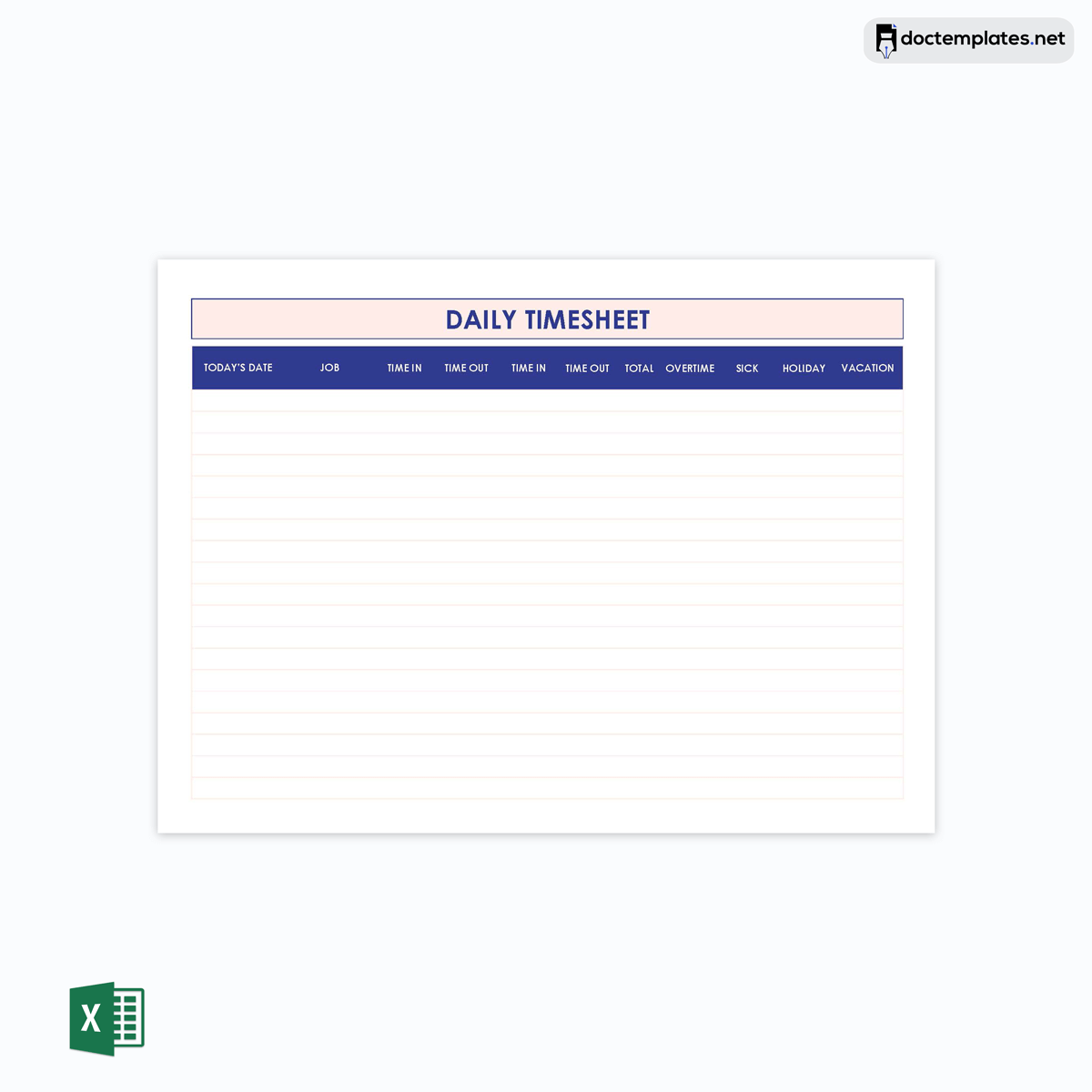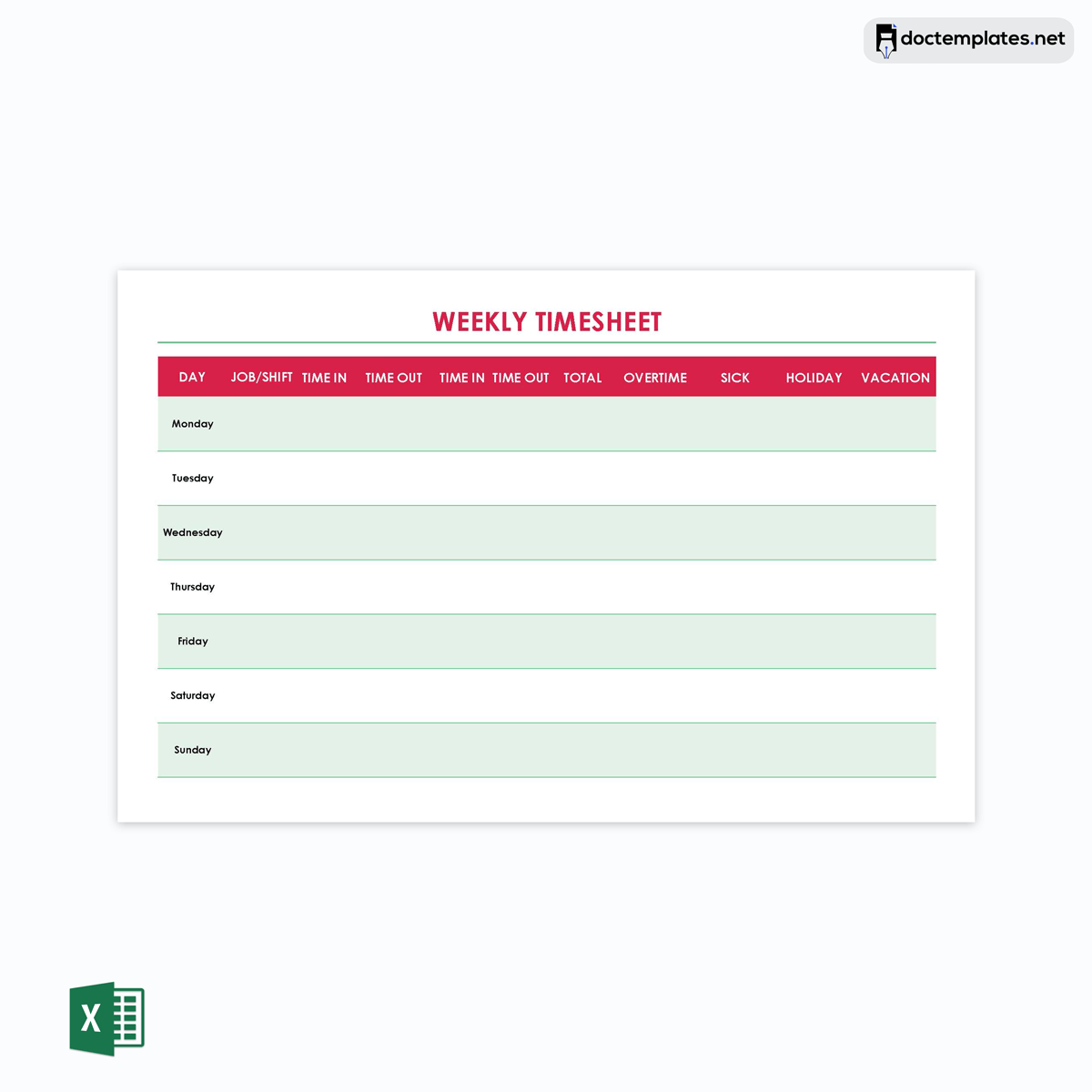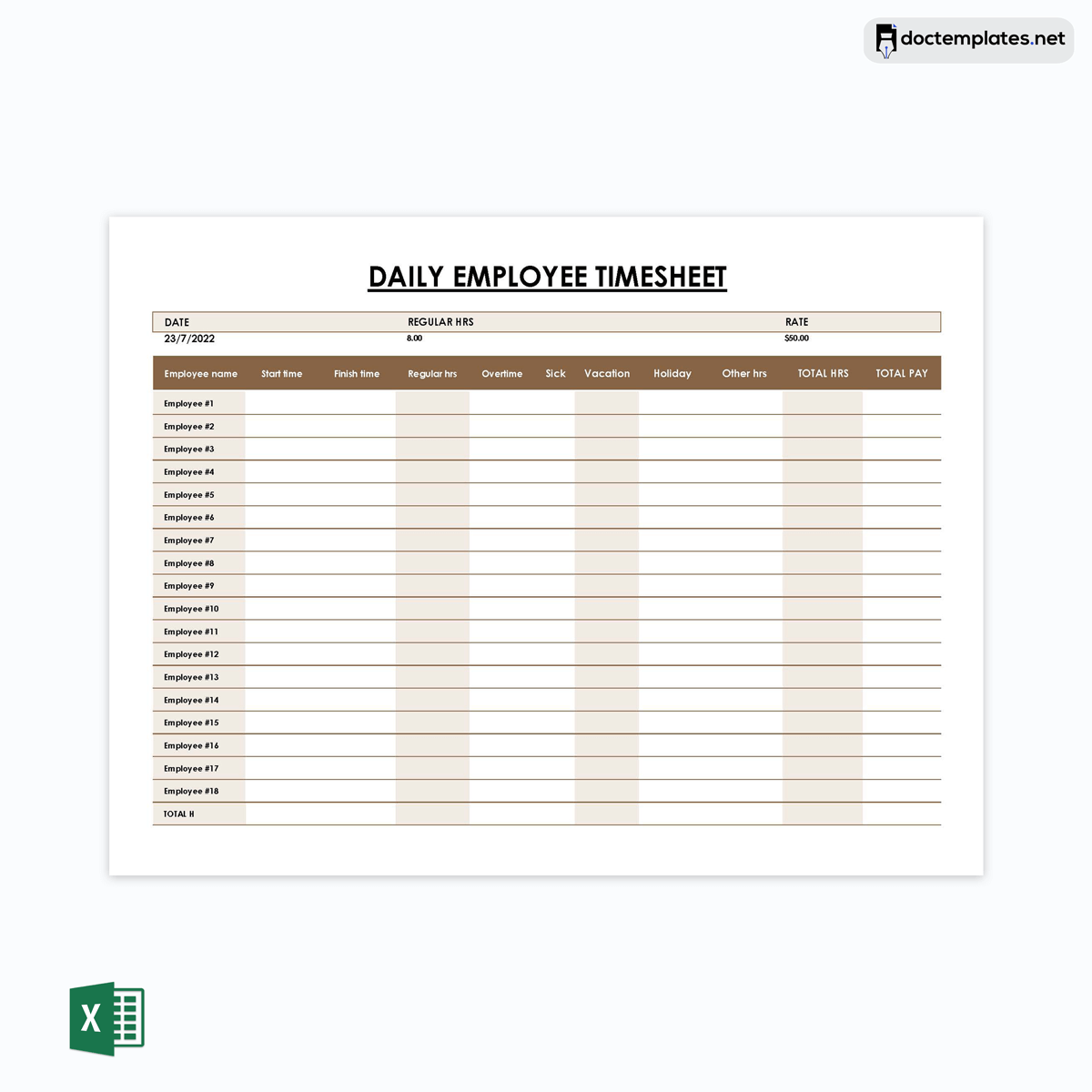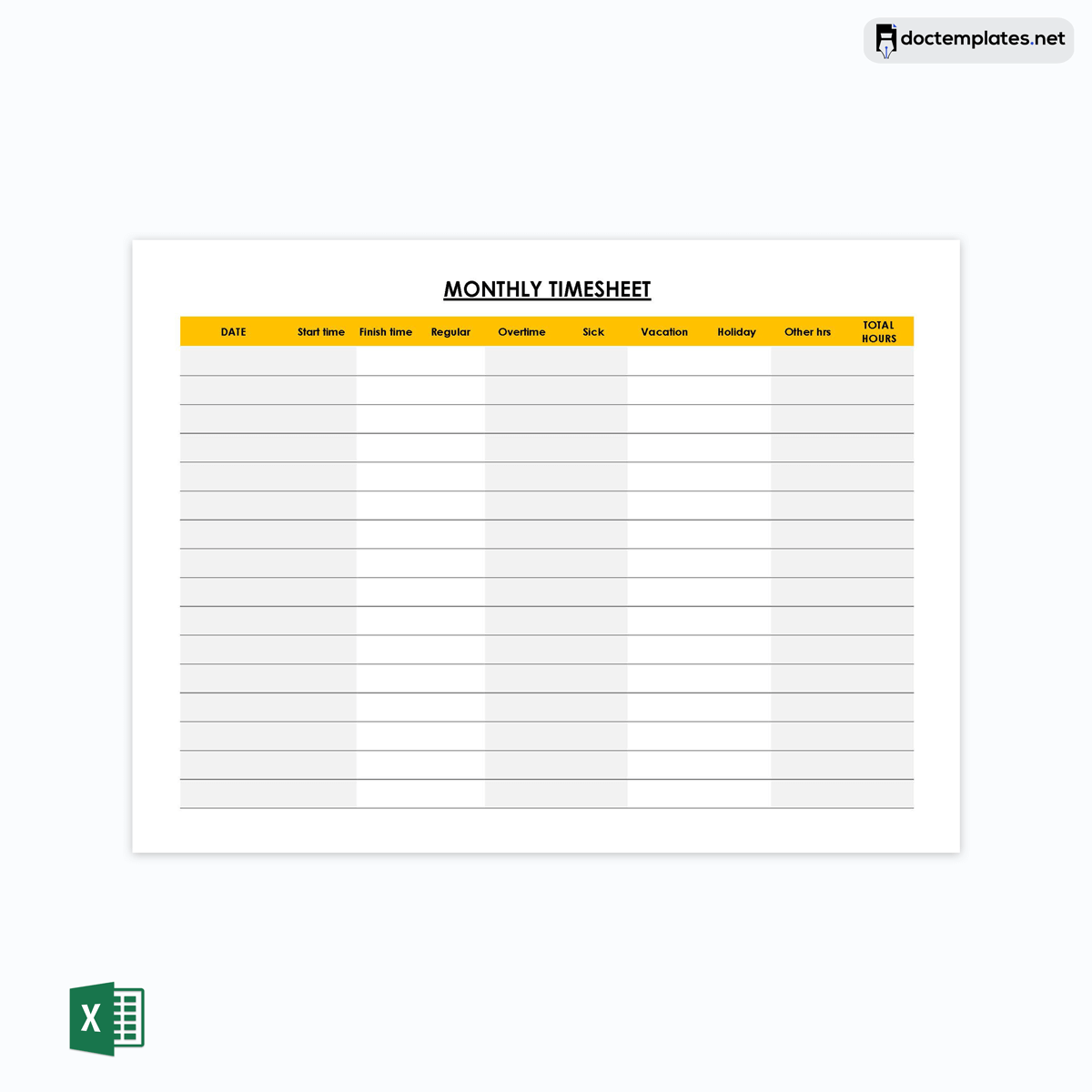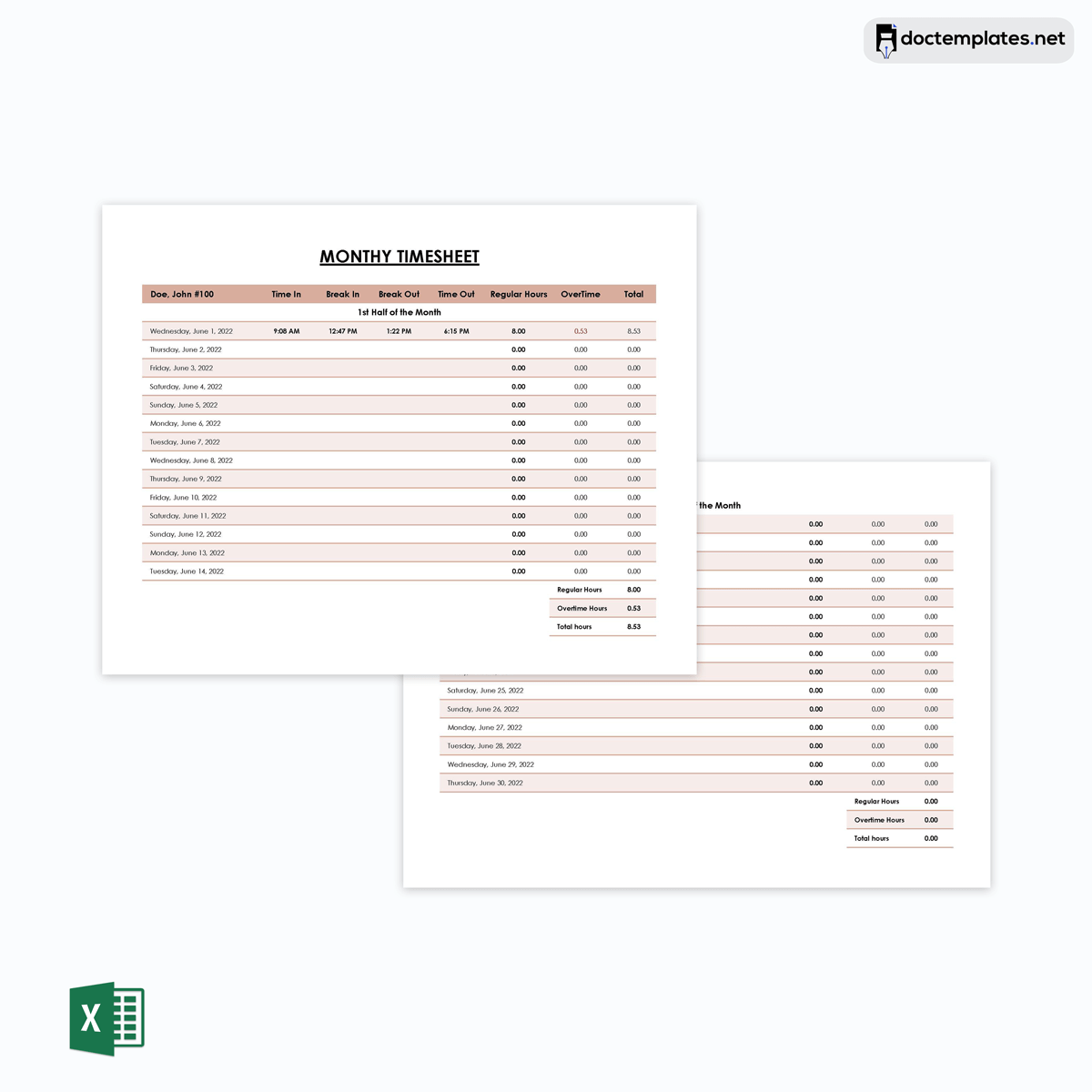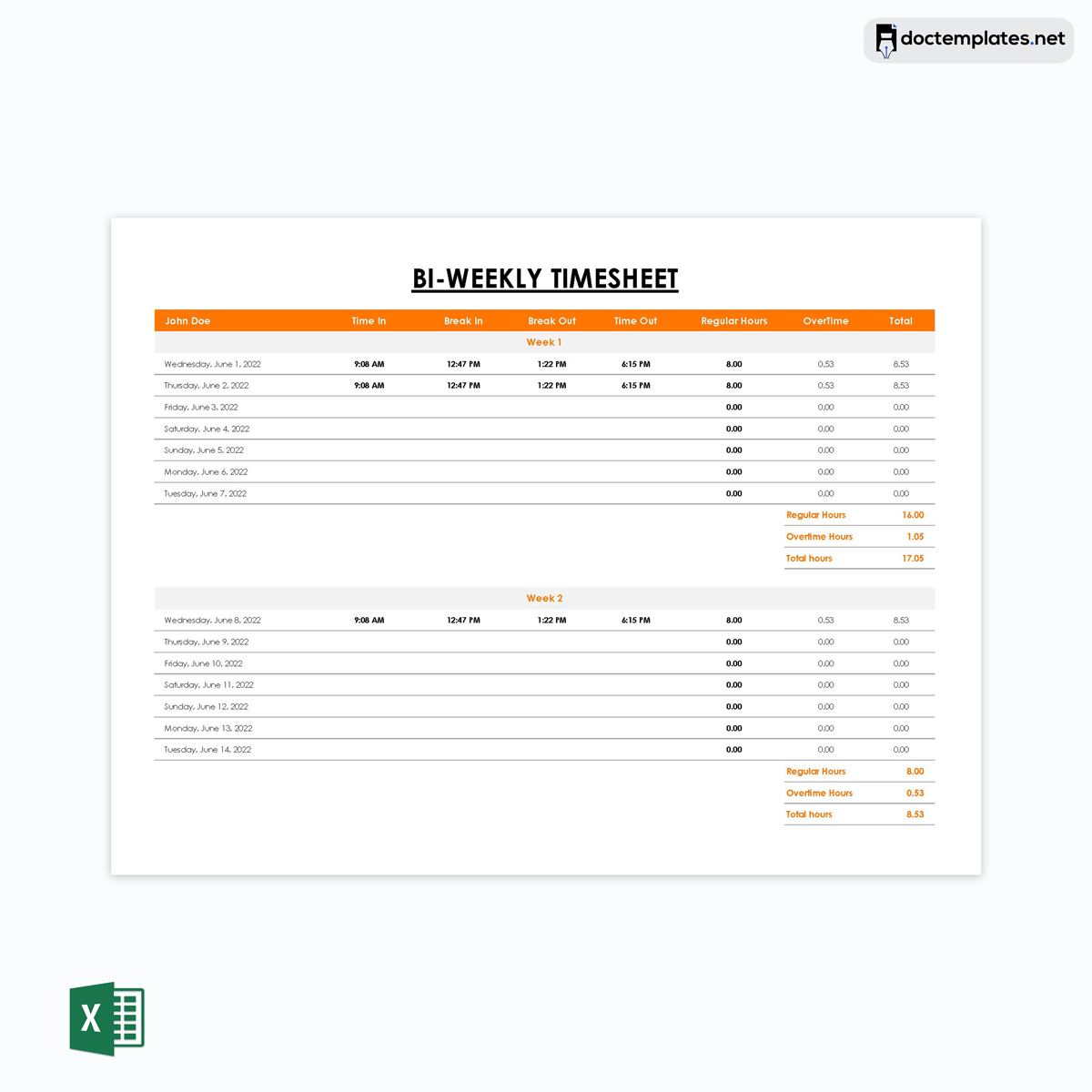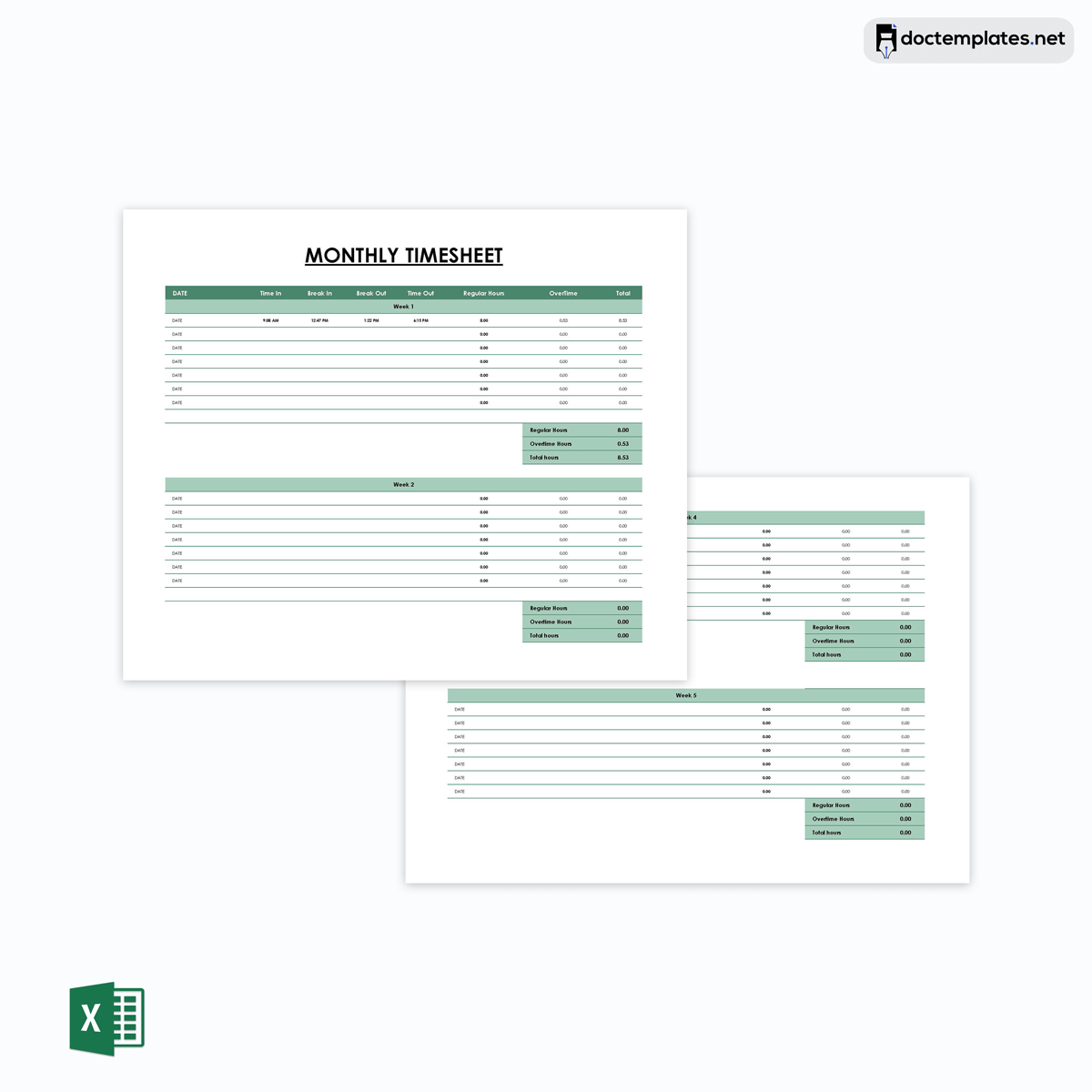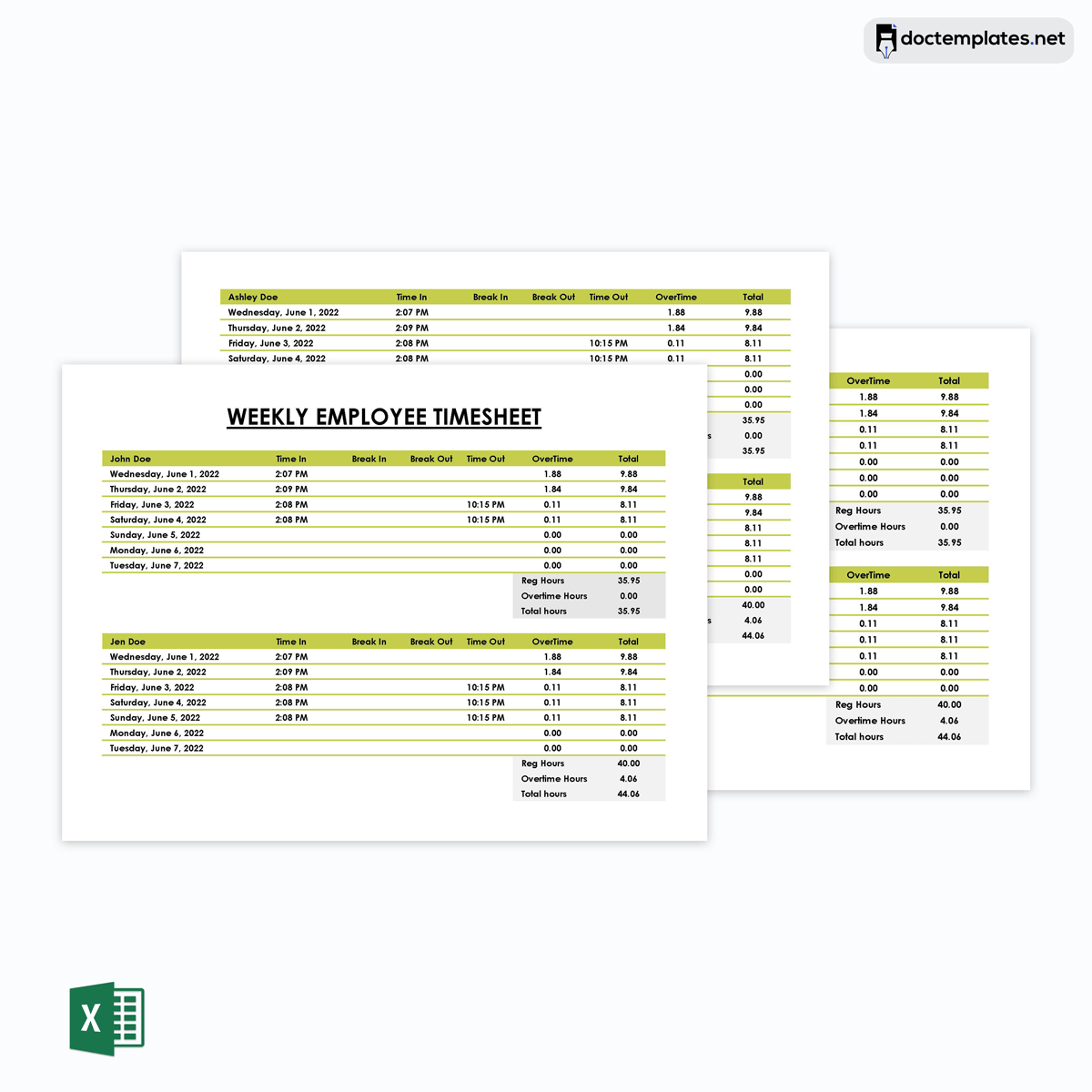An employee timesheet is a form of a data table employers commonly use to track the time employees spend working during a specific period.
Businesses commonly use employee timesheets to record and track time spent on projects, tasks, or clients.
At their most basic form, employee timesheets record the time and date when employees start and end their workdays, making them perfect for retail, food service, and other businesses that work in shifts. Thanks to employee timesheets, companies can gain insight into how much time their employees spend on every business aspect, including development, marketing, distribution, and customer service. That allows them to understand the number of regular and overtime hours every employee worked, keep all data in one place, and pay all workers correctly for their input.
Since timesheets represent physical and digital records, companies can use paper, spreadsheet software, online time-tracking software, and other methods to record their timesheets. However, it’s safe to say more user-friendly digital formats are increasingly replacing paper-based timesheets.
Still, these are the most commonly available types of employee timesheets:
- Paper-based timesheets: Punch cards and registers are the most common examples of paper-based timesheets, although more contemporary solutions are increasingly replacing them.
- Spreadsheet software: The most famous example of spreadsheet software is Excel. These tools are usually free to use and come in a table format.
- Online time-tracking software: As the most expensive solution, online time-tracking software comes with numerous functionalities and features.
Regardless of the chosen method, employee timesheets are most effective when combined with time cards, clock punches, or fingerprint clocks. According to the Fair Labors Standards Act (FLSA), companies can choose whichever type of employee timekeeping they prefer – as long as they provide complete and accurate information.
Employee Timesheet Templates
Timesheets come with plenty of advantages to both companies and their employees. Nevertheless, creating an employee timesheet template is a lot of work. Companies need to find a way to make these templates as detailed as possible while keeping them user-friendly. That means they must be simple to understand and easy to fill out.
Below are free-to-download and customizable templates that enable you to provide your workforce with accurate and easy-to-use timesheet templates in no time:
Applications of a Timesheet
Companies can use an employee timesheet for various purposes. The most common applications of timesheets include the following:
Payroll processing
With the help of timesheets, employers can easily keep track of work hours, holidays, leaves, accruals, and all other essential details for payroll processing.
Keeping in mind that inaccurate data entries are the main reason for payroll errors, employers can enjoy a trackable workflow for approving payrolls with employee timesheets. In addition, since timesheets make running payroll quicker and easier, there’s a lower risk of making costly errors.
Management accounting
Sometimes, it is difficult for managers to determine which tasks take more time than others. That can also affect their ability to predict start and end dates for specific tasks.
Employee timesheets are perfect for management accounting because they help managers keep track of task progression and update them on delayed tasks. These timesheets make it easy to modify the schedule and responsibilities when needed.
Law office timesheets
Law firms must keep detailed and up-to-date records of the services they offer and the hours spent working for clients because they usually bill their clients by the hour.
With law office timesheets, law firms can easily track how much time they have spent on each client during a specific period, making it significantly easier to create invoices and bill them.
Timesheets for freelancers
Most freelancers also charge their clients by the hour, so time tracking is their priority. However, they usually work away from their clients, so they need a separate tool to track how much time they spend working for each.
Time-tracking systems do precisely that. Moreover, these software tools let freelancers share their timesheets with clients, giving them a complete view of where their money is going.
Timesheets for accountants
Accountants benefit significantly from time-tracking systems because they can track the time they work and their bills. Since an accounting company’s success depends on how efficiently it can do business, timesheets can help accountants secure higher profits.
How to Manage Employee Timesheets
Managing timesheets is not necessarily a difficult task, but there are several steps every employer should follow to manage employee timesheets effectively:
Step 1: Explain why timesheets are important
The first step no employer should skip is explaining the importance of timesheets. Employees must understand that timesheets have tremendous power to affect the business, which is why they are an essential element of the company. Namely, they don’t only calculate paychecks but also improve and refine various business operations.
Highlighting the importance of timesheets is crucial for every business. Employers should inform new hires of the timesheet’s importance within their first few days while reminding existing employees of the matter once a year when they review the timesheet information.
Step 2: Set rules and regulations
Since timesheets play an essential role in an organization, employers must set rules and regulations that will be in place as long as they use a particular employee timesheet format. Setting clear rules and regulations will allow your employees to handle the whole process regarding timesheets from start to finish without assistance.
With clear rules and regulations, employees will understand the following:
- The frequency of submitting timesheets;
- When they need to turn in their timesheets;
- How the business tracks and pays overtime;
- The rounding policy for payroll;
- How they should label their entries;
- How they need to track client time.
Step 3: Teach your team how to handle timesheets
While filling in timesheets becomes a habit quickly, employers must ensure their workers know how to handle timesheets correctly. Once the employees understand their importance and become familiar with the rules and regulations, it’s time to teach them how to manage these timesheets.
The sooner the teaching begins, the better. Long-time employees should also review the process now and then.
Step 4: Categorize time
Time categorization at some companies goes beyond simple timestamping at the beginning and end of a workday. Many companies require categorizations for different jobs, tasks, or clients during a single shift. That is what time categorization is for, and it is easy to implement with employee timesheets.
The most common time categorization examples are:
- Billable hours;
- Non-billable hours;
- Overtime hours;
- Hourly rate;
- Different jobs.
Step 5: Use timesheet automation
Even though time categorization represents an essential part of an employee timesheet, it adds to the complexity. As such, employees will make mistakes as they fill out their timesheets. One way to minimize errors is to use timesheet automation.
Modern time-tracking apps often include timesheet automation, which reduces the confusion and complexity of filling out timesheet templates.
Step 6: Send timesheet reminders
Timesheet reminders are an excellent way to ensure all employees promptly fill in the required information. That ensures their payrolls will arrive on time. However, even with timesheet automation, employees should review the entered data to check if everything is in order. Timesheet reminders are ideal for that. Employers can choose from several types, including emails, push notifications, and text messages.
Step 7: Approve the timesheets
Once employees submit their timesheets, employers must approve them before activating the payroll. It is usual for errors to slip here and there, so you will surely catch some inconsistencies even with the most contemporary software solutions.
The final approval can eliminate any last-minute mistakes and allow companies to double-check the entered information before completing a pay period.
How to Make Your Employee Timesheet Effective
Every employer wants to make their employees’ timesheets more effective. The tips below will help companies create timesheets that employees will have no trouble filling in with the needed information:
Instruct on submitting timesheets in an employee handbook
An employee handbook should inform employees about filling in and submitting their timesheets. Using the company’s policies and due dates, employers can easily instruct how the workforce should track and record time.
Use a consistent timekeeping method
Companies must develop a timekeeping method and stick to it if they want to stay organized. Making frequent changes only confuses employees about completing their timesheets correctly, so being consistent with a particular timekeeping method is a road to success.
Review timesheets before improving
Employees should review every timesheet before handing it in because mistakes can occur. For example, they should check the entered information and sign their timesheets before submitting them. That will prevent workers from forging the data.
Set a regular schedule
The whole concept of timesheets revolves around improving time management and ensuring all employees receive fair pay for their work.
However, to streamline the entire process, employers should set a regular schedule requiring employees to turn in their timesheets on the same day for every pay period.
Enter accurate information
Once employees hand in their timesheets, employers must review the details to ensure everything is accurate. Recording less than the employees worked can have grievous consequences, and entering the correct information every time is essential.
Use time and attendance software
A significant advantage of time and attendance software is that timesheet automation removes the factor of man-made mistakes and optimizes the whole process to be simpler and faster.
Time and attendance software solutions can automatically upload all workers’ hours, eliminating the need to enter employee information manually.
Pros and Cons of Using Timesheets
Similarly to any other business procedure, using timesheets also comes with a unique set of pros and cons.
Pros
Some advantages of using timesheets are as follows:
Reduce time wastage
Timesheets give employers an overview of where they are wasting labor and man-hours. With the help of timesheets, companies can quickly reduce time wastage by optimizing tasks and improving time management for those that take longer than necessary.
Accurate and automated billing
Implementation of timesheets comes with the minimization of errors. Timesheets prove how employees do their job by informing employers and clients about the time spent on each project. That way, it is easy to bill accurately.
Moreover, automated billing and invoicing are outstanding advantages for companies that bill their clients by the hour. Automated billing can even increase revenue.
Improve project management
Employee timesheets can improve project management because they:
- Track time on a project, giving employers insight into which employees need to qualify for a new role, project, or job;
- Identify areas where employees require more time or additional training;
- Analyze time usage and determine which employees are more suitable for particular tasks;
- Identify the availability of employees;
- Allow project managers to supervise every project’s progress;
- Enable project managers to measure the project’s overall efficiency rate;
- Help project managers estimate costs and compare them to actual costs.
Save money for your company
Since timesheets give companies a detailed overview of what their employees are doing during work hours, executives can compare the amount of time spent working with the output to measure efficiency. Finding who the efficient workers are can save a lot of money for the company.
Submit client invoices
Timesheets are an excellent addition to client invoices because they accurately report how many hours employees worked for clients using the company’s services.
Build a historical database
Timesheets allow companies to build historical databases they can use for future projects. In addition, communication and time management becomes significantly easier when companies rely on a historical database.
Improve estimates
Whether your client wants some estimates on time, costs, or resources, employee timesheets are a perfect way to improve them and present clients with accurate information.
Enhance agility
With a proper time-tracking tool such as employee timesheets, companies can enhance their agility, making them more flexible to adapt to issues or new circumstances.
Cons
There are some disadvantages to using a timesheet. These are:
Lower employee morale
Many employees view timesheets as a tool that enables employers to spy on them. Feeling like someone is standing over their shoulder at all times can negatively affect some employees by decreasing their morale and feeling of autonomy.
Timesheet guilt
Employees can also feel the timesheet guilt because they needed more time than initially planned for a task. Some will even report inaccurate numbers and receive lower pay than they should.
Timesheet fraud
Even though employee timesheet fraud is difficult to accomplish with present-day tools and solutions, it is still possible. Inaccurate reporting is still present, making many companies lose money.
Timesheet fraud is far more challenging to achieve these days. However, that does not mean it is out of the picture. Companies must ensure accurate time reporting to prevent fraud and save money.
Difficult to track some tasks
Employee timesheets can not track all tasks. Meetings, catch-ups, and brainstorming sessions are only some examples of billable tasks that are much more difficult to note and report efficiently.
Frequently Asked Questions
What is a time entry?
A time entry includes the time employees start and finish working on a task. Time entries are part of timesheets employers use for client billing and payroll processing.
How long do you need to keep timesheets?
According to the Fair Labor Standards Act, all companies should keep their timesheets for two years.
What are the legal requirements for timesheets?
While there are no legal requirements for employee timesheets, employers must ensure accurate billing and pay. Any inaccurate information can lead to legal proceedings.
How often should you fill out a weekly timesheet?
Every company has its policy on filling out weekly timesheets, but it’s always better to update information daily.
How can you manage absences and vacations on timesheets?
The best way to manage absences is to create tasks with “Sickness” or “Vacation” labels and use them during the period when employees are absent.
Should you keep timesheets confidential?
Employers should inform all company members about what their colleagues are working on at any moment. That is why timesheets should not be confidential and be available to all employees.
